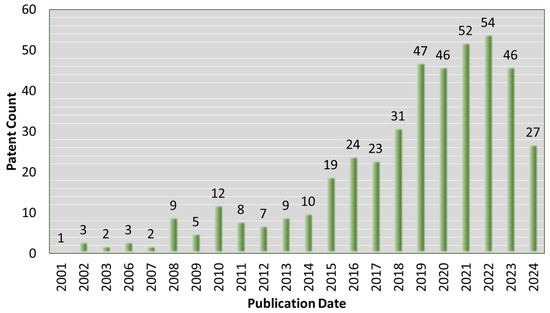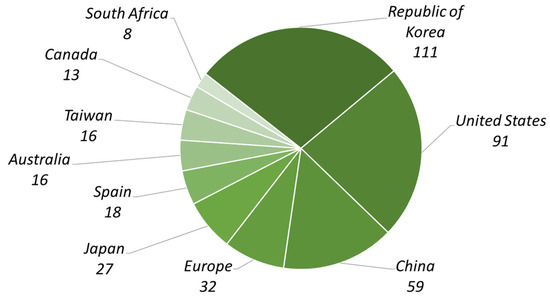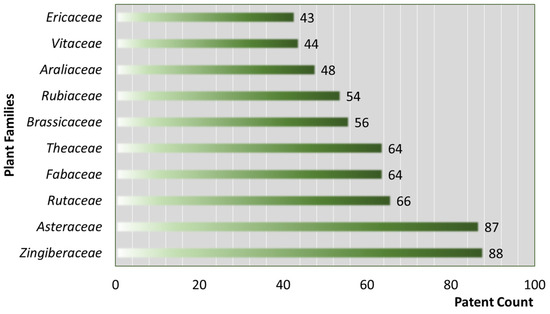Abstract
Medicinal plants from the Lamiaceae family hold significant promise as functional food ingredients due to their high content of essential dietary fiber and bioactive compounds. Lamiaceae plants are rich in phenolic acids, flavonoids, and alkaloids, contributing to their antioxidant and anti-inflammatory properties. This study utilizes a comprehensive patent analysis to explore recent trends in functional foods developed from Lamiaceae plants. We examined patents from databases using Cooperative Patent Classification (CPC) codes relevant to dietetic products and food compositions. Findings indicate a surge in patents related to Lamiaceae-based dietary supplements, particularly those targeting metabolic health, anti-aging, cognitive function, and bone and liver health. Mentha, Scutellaria, Salvia, and Perilla are the most represented genera, with dietary supplements showing potential in chronic disease prevention. This analysis highlights the growing commercial and therapeutic interest in Lamiaceae-derived functional foods, particularly for preventive health applications.
1. Introduction
Medicinal plants from the Lamiaceae family are increasingly recognized for their potential applications in functional foods due to their rich bioactive compounds and diverse health benefits [1]. This family, known for its medicinal and aromatic properties, contains a variety of species that exhibit significant antioxidant, anti-inflammatory, and antimicrobial activities, making them suitable for functional food development [2]. The Lamiaceae family is characterized by a diverse phytochemical profile, including phenolic compounds, such as rosmarinic acid, caffeic acid [3], and flavonoids like apigenin and quercetin [4], which contribute to their antioxidative and anti-inflammatory properties [2,5]. Additionally, terpenoids, such as menthol, thymol, and caryophyllene, commonly found in essential oils, provide antimicrobial and digestive benefits [2,6,7].
Moreover, alkaloids like stachydrine and scutellarein offer neuroprotective and cardiovascular health benefits while polysaccharides and dietary fibers enhance gut health through prebiotic effects. Other notable bioactives include coumarins like umbelliferone and tannins which are linked to anticoagulant and antimicrobial properties [5]. For instance, species such as Salvia officinalis and Origanum vulgare have demonstrated strong antiradical activities that help counteract oxidative stress, a key factor in neurodegenerative diseases [8,9]. These phytochemical and functional attributes make Lamiaceae plants ideal candidates in innovative functional food products aimed at improving overall health and preventing chronic disease.
Research further indicates that specific Lamiaceae species have pharmacological effects against certain health conditions [4,10]. For example, Clinopodium vulgare has demonstrated potential in managing ailments like gastric ulcers and diabetes [11]. Additionally, Lamiaceae seeds, rich in fiber and starch, are being explored as alternatives to cereals in food applications while their phenolic-rich extracts show anti-hemolytic and anti-mutagenic properties supporting their therapeutic potential [3].
The diverse phytochemical profiles of Lamiaceae species suggest their value in developing functional foods aimed at health enhancement and disease prevention [9]. With rising consumer interest in natural remedies, these plants provide an opportunity for the food industry to create formulations that meet the demand for natural alternatives while addressing specific health conditions like metabolic regulation and oxidative stress [3].
By incorporating these plants into functional foods, it may be possible to offer consumers a unique combination of dietary fiber and bioactive compounds that can support improved digestion, cardiovascular health, reduced inflammation, and overall well-being [12]. As a result, the use of Lamiaceae-based food products is gaining attention for their potential to address chronic health conditions and promote a balanced diet [13].
This study presents an overview of patents related to functional foods derived from the Lamiaceae family, highlighting innovations and recent trends. By using six Cooperative Patent Classification (CPC) codes related to the functional foods based on medicinal plants in the family Lamiaceae, a patent analysis was carried out to identify what has been patented in this area. These codes include A61K36/53, A23V2002/00, A23L33/00, A23L33/10, A23L33/105, and A23L33/11 [14].
2. Materials and Methods
2.1. Data Collection
The patent analysis was conducted using the Espacenet Patent Search [15], The Lens [16], and Google Patents [17] databases. These databases were chosen for their complementary strengths:
- Google Patents: utilized for accessing full-text PDF patent documents, providing detailed descriptions and claims for analysis.
- The Lens: a global database offering comprehensive coverage of published patents from multiple jurisdictions, enabling broad trend analysis.
- Espacenet: maintained by the European Patent Office (EPO), this database was specifically selected for its reliable classification system, particularly CPC codes, which are administered by the EPO.
2.2. Search Strategy
The search focused on patents related to dietetic products and food composition, function, processes, or quality modification, linked to the Lamiaceae species. The search process relied exclusively on CPC codes to ensure precision and relevance. No keywords were used. Specific CPC codes were used, including A61K36/53, A23V2002/00, A23L33/00, A23L33/10, A23L33/105, and A23L33/11 [14]. These codes were selected for their specificity in order to capture patents that aligned with the dietary and functional applications of Lamiaceae plants. The codes covered a wide range of functionalities and ensured a comprehensive exploration of the topic.
2.3. Time Frame and Filters
The search covered patents published between 2001 and 2024 (up to July 16) to capture recent trends while providing historical context. The filters applied included jurisdiction (global coverage), publication type (granted patents), and patent family (simple families).
2.4. Patent Selection Criteria
The patents were selected based on their explicit relevance to the Lamiaceae species, emphasizing dietary application, functional food formulation, and health-related benefits. Each patent was analyzed for a target health benefit, the plant genera involved, and its associated technological innovations.
2.5. Challenges and Mitigation Strategies
The challenges faced included overlapping patents across databases, ambiguous classification under multiple CPC codes, and incomplete data. Duplicate patents were removed by cross-referencing the patent numbers, ambiguous entries were manually reviewed to confirm their relevance to the Lamiaceae species, and patents with insufficient information were excluded to ensure data quality.
3. Results and Discussion
3.1. Cooperative Patent Classification Codes Related to Lamiacea-Based Functional Foods
In this study, the codes were selected for their specificity in order to capture patents that aligned with the dietary and functional applications of Lamiaceae plants. The codes cover a wide range of functionalities and ensure a comprehensive exploration of the topic.
The A61K36/53 classification covers plants from the Lamiaceae or Labiatae family, commonly known as the mint family. This group includes well-known species, such as thyme, rosemary, and lavender, which are often used in various applications for their aromatic and medicinal properties.
The A23V2002/00 classification pertains to food composition and encompasses the functional role of food ingredients as well as the processes involved in preparing or enhancing foodstuffs. This code broadly applies to innovations related to how food ingredients function and how food is processed.
The A23L33/00 classification focuses on modifying the nutritional quality of food. It includes dietetic products and covers the preparation or treatment methods designed to alter or enhance a food’s health-related qualities. This classification addresses innovations that improve the dietary value of food products.
Expanding on this, the A23L33/10 classification builds on A23L33/00 by specifically addressing food modifications that involve the use of additives. These additives are intended to enhance the nutritional profile of food, making it more suitable for dietetic purposes or to target specific health benefits.
The A23L33/105 classification further specifies modifications to the nutritional quality of foods that include plant extracts. This category covers additives derived from plants, synthetic versions of these compounds, or their derivatives that contribute to additional health benefits or functional properties in dietetic products.
Finally, the A23L33/11 classification involves modifications that include plant sterols or similar compounds such as phytosterols. Building on the previous classifications, this category specifically focuses on additives that support cholesterol management and cardiovascular health, often using compounds derived from plant extracts.
To enhance understanding of the classification system’s contribution to our patent analysis, Table 1 provides a clear and structured visualization of the CPC codes, detailing their scope and relevance to the study of Lamiaceae-based functional food. It should be noted that relevance is confirmed when the CPC code A61K36/53 intersects with other CPC codes in the set, indicating Lamiaceae-based innovations specifically tied to functional foods. Additionally, this highlights the interdisciplinary nature of patents involving Lamiaceae plants across medicinal and dietary contexts.

Table 1.
A summary of the CPC codes used in this study, their scope, and their relevance to Lamiaceae-based functional food.
3.2. Patent Trends in Lamiaceae Application
Upon breaking down patents filed in the years 2001–2024, we found that 440 patents were granted along with 200 simple patent families. About 84% of patents were published in the last decade, reflecting a sharp increase in interest in Lamiaceae for dietary use (Figure 1).

Figure 1.
The number of Lamiaceae-based functional food patents granted per year between 2001 and 2024 (up to July 16).
Between 2021 and 2024, there was a noticeable fluctuation in the number of patent filings related to Lamiaceae-based functional food. The year 2021 marked a high point of 52 patents, demonstrating a growing interest in this field. This upward trend continued into 2022, reaching a peak of 54 patents, indicating heightened innovation and commercial interest in Lamiaceae for dietary and health-related applications. However, in 2023, the number of patent filings slightly declined to 46, suggesting a stabilization in patenting activity. As of 2024, with 27 patents published, there is reduced activity possibly due to patent application processing timelines or shifts in research focus. Despite this, the years 2021–2022 stand out as the peak activity time and reflect the most significant growth in innovation and patent filings within this timeframe, signaling an interest in Lamiaceae-based functional food.
Generally, this trend suggests a growth in recognition of the therapeutic and preventive benefits of these plants. The patents demonstrate innovations ranging from specific bioactive extraction methods to novel combinations of Lamiaceae with other functional ingredients for enhanced health benefits.
3.3. Patent Activity by Region
In recent years, several regions have shown a notable increase in patent filings related to Lamiaceae-based functional food, which could significantly impact global trends in health and wellness. The top 10 jurisdictions below represent about 90% of the total jurisdictions identified in the collected patents (Figure 2). This distribution illustrates regional strategies and priorities in functional food development, providing insight into how Lamiaceae plants are shaping global health trends.

Figure 2.
The top 10 jurisdictions identified by their number of patents related to Lamiaceae-based functional food.
In the lead with 111 patents, Korea showcases a strong focus on Lamiaceae-based innovation, particularly in dietary supplements and functional foods. This reflects broader Asian health trends favoring natural, preventive health solutions. With its 91 patents, the U.S. emphasizes its role as a global hub for functional food innovation. Its Lamiaceae-based patents focus on chronic disease management, digestion, and cognitive health, aligning with consumer trends in the health and wellness markets. Holding 59 patents, China bridges traditional medicine and modern technology, enhancing functional food development in local and global markets. This is significant given China’s extensive domestic market and export capability. With its 32 patents, the European Union’s interest signals its commitment to preventive health through functional foods. The region’s strict regulations ensure scientific backing for Lamiaceae-based innovations, fostering consumer trust. Twenty-seven patents underscore Japan’s focus on natural solutions to age-related health issues like cognitive decline. These innovations align with the country’s commitment to longevity and well-being, setting trends for aging populations globally.
3.4. Main Lamiaceae Genera in Patents
The analysis identified several prominent genera within the Lamiaceae family that were the focus of patents related to dietary applications (Figure 3). The key genera include Mentha (29 patents), Scutellaria (24 patents), Salvia (21 patents), and Perilla (17 patents). These genera are highlighted due to their unique composition and bioactive compounds that align well with the demands of functional food markets.

Figure 3.
The main Lamiaceae genera concerned by the collected patents.
3.5. Top Plant Families Associated with Lamiaceae
Patents also revealed frequent co-mentions of Lamiaceae with other plant families, suggesting synergistic formulations. From the 200 patent documents related to the Lamiaceae family, other families seem to be relevant in this area (Figure 4). The top families include, among others, Zingiberaceae (88 mentions), Asteraceae (87 mentions), Rutaceae (66 mentions), and Fabaceae (64 mentions). The high citation of these families indicates a trend toward combining Lamiaceae species with other plant families to enhance the overall health effects of functional food products.

Figure 4.
The top 10 plant families associated with Lamiaceae from the collected patent documents.
3.6. Dietary Supplement Targets
Based on this study, a summary of the most cited dietary supplement targets from the studied patent documents are presented in (Figure 5). The patents primarily target five health categories. The prevalence of these targets underscores a commercial interest in functional foods that address lifestyle-related health concerns and age-related conditions.

Figure 5.
A summary of the most cited dietary supplement targets from the studied patent documents.
The patents targeting metabolic health often highlight supplements designed for obesity management, weight loss, and improved lipid metabolism. These products typically leverage the bioactive compounds in Lamiaceae plants, such as polyphenols and flavonoids, known for their potential to regulate fat metabolism and support healthy weight management (patent AU2006312947B2 [18]). By incorporating these compounds, the supplements aim to help users maintain a balanced metabolism and reduce the risk of metabolic disorders.
A significant portion of patents focus on anti-aging formulations that support skin health and promote a youthful appearance. Products in this category are often enriched with antioxidants from Lamiaceae plants which help combat oxidative stress—a key factor in the aging process (patent KR102065185B1 [19]). These supplements are marketed for their potential to protect the skin from environmental damage, maintain hydration, and reduce visible signs of aging, appealing to consumers interested in cosmetic benefits as well as health maintenance.
Supplements aimed at enhancing cognitive function represent another major area of patent activity. These products are formulated to improve memory, focus, and mental clarity, leveraging the neuroprotective properties of specific Lamiaceae compounds (patents US10485840B1 [20] and US10369182B2 [21]). By preventing oxidative damage and supporting neurotransmitter function, these supplements seek to address cognitive decline, especially as part of an age-related health strategy.
Formulations targeting bone and liver health emphasize the benefits to bone growth, joint health, detoxification, and liver support. Compounds from Lamiaceae plants are integrated into these products for their potential to promote joint flexibility, stimulate bone mineralization (patents KR102566496B1 [22] and CA2871478C [23]), and enhance liver detoxification pathways (patent EP3405207B1 [24]). Such supplements are geared toward supporting musculoskeletal and organ health, which are crucial for maintaining overall wellness as people age.
As consumer preferences continue to shift toward natural, plant-based ingredients that promote holistic health, the bioactive compounds from Lamiaceae genera address these needs effectively. Their broad spectrum of health benefits positions them as ideal candidates for incorporation into functional foods, meeting the demand for products that support immunity, digestion, and the management of chronic conditions.
4. Conclusions
The analysis of patent data related to Lamiaceae-based functional food reveals a substantial increase in the interest in and innovation around these medicinal plants. The patents highlight the versatility of Lamiaceae species, especially Mentha, Scutellaria, Salvia, and Perilla, in promoting metabolic health, cognitive function, anti-aging, and organ health. The convergence of these dietary supplements with preventive health objectives illustrates the Lamiaceae family’s potential to contribute significantly to functional food markets. Continued research and innovation in this area is anticipated to expand the range of its application, offering more tailored nutritional approaches to chronic disease prevention. For a different perspective, further research could focus on in-depth biochemical studies to explore the mechanisms of the bioactive compounds found in Lamiaceae. Additionally, patent trend analysis of emerging markets could provide insight into shifts in global interest, potentially supporting a more tailored approach to dietary supplementation using Lamiaceae-based products.
Author Contributions
Conceptualization, R.E.B. and A.F.; methodology, R.E.B. and A.F.; validation, A.F.; formal analysis, R.E.B. and A.F.; investigation, R.E.B. and A.F.; data curation, R.E.B. and A.F.; writing—original draft preparation, R.E.B.; writing—review and editing, A.F.; visualization, A.F.; supervision, A.F. All authors have read and agreed to the published version of the manuscript.
Funding
This research received no external funding.
Institutional Review Board Statement
Not applicable.
Informed Consent Statement
Not applicable.
Data Availability Statement
The data presented in this study are available within this manuscript. The following supporting information can be downloaded at: https://sciforum.net/paper/view/18825 (accessed on 11 October 2024). Poster: El Boukhari, R.; Fatimi, A. Functional Foods based on Medicinal Plants of the Family Lamiaceae: a patent analysis overview. The 4th International Electronic Conference on Nutrients (IECN2024), Basel—Switzerland, 16–18 October 2024.
Acknowledgments
The authors acknowledge the European Patent Office, Cambia Institute, and Google for the databases and search services used in this study. Additionally, the authors acknowledge the Academic Editor and the Chair of the 4th International Electronic Conference on Nutrients for the opportunity to present this work in the session “Innovation in Dietary Choices”.
Conflicts of Interest
The authors declare no conflicts of interest.
References
- El Boukhari, R.; Fatimi, A. Patent analysis of four Lamiaceae-derived plants: A medicinally active resource against new health challenges. Med. Sci. Forum 2023, 21, 1. [Google Scholar] [CrossRef]
- Isnaini, N.; Annisa, A.; Prajaputra, V.; Maryam, S.; Idroes, R.; Khairan, K. Chemical composition and biological activities of essential oils in the family Lamiaceae. IOP Conf. Ser. Earth Environ. Sci. 2024, 1356, 012097. [Google Scholar] [CrossRef]
- Chrysargyris, A. It Runs in the Family: The Importance of the Lamiaceae Family Species. Agronomy 2024, 14, 1274. [Google Scholar] [CrossRef]
- Yasir, M.; Jamil, N.; Nazir, A.; Kanwal, Q.; Mehrun, N.; Athir, N.; Mustafa, R.; Al-Mijalli, S.H.; Iqbal, M.; Ahmad, N. Hemolytic activity and protective potential of Lamiaceae plants seed extracts and their bioactive components profiling having potential for functional foods and nutraceutical formulations. Biocatal. Agric. Biotechnol. 2022, 46, 102556. [Google Scholar] [CrossRef]
- Kowalczyk, T.; Merecz-Sadowska, A.; Ghorbanpour, M.; Szemraj, J.; Piekarski, J.; Bijak, M.; Śliwiński, T.; Zajdel, R.; Sitarek, P. Enhanced Natural Strength: Lamiaceae Essential Oils and Nanotechnology in In Vitro and In Vivo Medical Research. Int. J. Mol. Sci. 2023, 24, 15279. [Google Scholar] [CrossRef] [PubMed]
- El Boukhari, R.; Fatimi, A. Thymol’s Innovative Health and Medicine Applications: An Overview Based on Patent Analysis and Patent Review. Curr. Tradit. Med. 2025, 11, e150724231962. [Google Scholar] [CrossRef]
- El Boukhari, R.; Nahid, H.; Fatimi, A. Menthol: The Story of a Plant-Derived Molecule Through the Patents. In Intellectual Property Issues in Life Sciences: Disputes and Controversies, 1st ed.; Keswani, C., Possas, C., Eds.; CRC Press: Boca Raton, FL, USA, 2024; pp. 216–233. [Google Scholar]
- Campinho, A.; Alves, J.; Martins, R.; Vieira, M.; Grosso, C.; Delerue-Matos, C. Exploring the Antiradical Potential of Species from Lamiaceae Family: Implications for Functional Food Development in the Context of Neurodegenerative and Neuropsychiatric Diseases. Biol. Life Sci. Forum 2023, 26, 33. [Google Scholar] [CrossRef]
- Moshari-Nasirkandi, A.; Alirezalu, A.; Alipour, H.; Amato, J. Screening of 20 species from Lamiaceae family based on phytochemical analysis, antioxidant activity and HPLC profiling. Sci. Rep. 2023, 13, 16987. [Google Scholar] [CrossRef] [PubMed]
- El Boukhari, R.; Fatimi, A. A review of the patentability of rosemary-derived drugs and bioactive compounds. Drugs Drug Candidates 2023, 2, 172–188. [Google Scholar] [CrossRef]
- Qureshi, K.A.; Parvez, A.; Uzzaman Khan, M.M.; Aspatwar, A.; Atiya, A.; Elhassan, G.O.; Khan, R.A.; Erattil Ahammed, S.Y.; Khan, W.U.; Jaremko, M. Exploring nature’s hidden treasure: Unraveling the untapped phytochemical and pharmacological potentials of Clinopodium vulgare L.—A hidden gem in the Lamiaceae family. Heliyon 2024, 10, e24781. [Google Scholar] [CrossRef] [PubMed]
- Saleem, H.; Yaqub, A.; Rafique, R.; Ali Chohan, T.; Malik, D.-e.-S.; Tousif, M.I.; Khurshid, U.; Ahemad, N.; Ramasubburayan, R.; Rengasamy, K.R.R. Nutritional and medicinal plants as potential sources of enzyme inhibitors toward the bioactive functional foods: An updated review. Crit. Rev. Food Sci. Nutr. 2024, 64, 9805–9828. [Google Scholar] [CrossRef] [PubMed]
- El Boukhari, R.; Fatimi, A. Extract of Rosemary as Food Additive: The Landmark Patents. Biol. Life Sci. Forum 2023, 26, 37. [Google Scholar] [CrossRef]
- European Patent Office. Espacenet Glossary. Available online: https://worldwide.espacenet.com/patent/help/espacenet-glossary (accessed on 16 July 2024).
- European Patent Office. Espacenet Patent Search. Available online: https://worldwide.espacenet.com (accessed on 16 July 2024).
- Cambia Institute. The Lens Patent Data Set. Available online: www.lens.org (accessed on 16 July 2024).
- Google. Google Patents Research Data. Available online: https://patents.google.com (accessed on 16 July 2024).
- Heuer, M.A. Diet Supplement and Method for Weight-Loss. AU Patent AU2006312947B2, 1 December 2011. [Google Scholar]
- Yang, S.J. Composition for Improving Skin Conditions with Improved Anti-Bacterial Anti-Inflammatory Anti-Wrinkling and Skin Whitening Property. KR Patent KR102065185B1, 13 January 2020. [Google Scholar]
- Jung, J.M. Method for Preparing Functional Health Food Comprising Aloeswood for Promoting Memory and Perceptivity. US Patent US10485840B1, 26 November 2019. [Google Scholar]
- Cohen, S. Compositions and Methods for Treating Insomnia and Other Sleep Related Disorders. US Patent US10369182B2, 6 August 2019. [Google Scholar]
- Jang, H.D.; Lee, S.H.; Lee, D.K.; Lee, H.K. A Pharmaceutical Composition for Preventing or Treating Osteoporosis Comprising MSM Calcium and Rosemary Extract as an Active Ingredient. KR Patent KR102566496B1, 11 August 2023. [Google Scholar]
- Hong, S. Pleuropterus Multiflorus Extract and Dipsacus Asperoides Extract for Stimulating the Secretion of Insulin-Like Growth Factor and Promoting Bone Structure Growth, and Method for Preparing Same. CA Patent CA2871478C, 12 April 2016. [Google Scholar]
- Hay, L.E. Detoxifying Composition for Oral Administration and Method for Preparing Same. EP Patent EP3405207B1, 7 October 2020. [Google Scholar]
Disclaimer/Publisher’s Note: The statements, opinions and data contained in all publications are solely those of the individual author(s) and contributor(s) and not of MDPI and/or the editor(s). MDPI and/or the editor(s) disclaim responsibility for any injury to people or property resulting from any ideas, methods, instructions or products referred to in the content. |
© 2024 by the authors. Licensee MDPI, Basel, Switzerland. This article is an open access article distributed under the terms and conditions of the Creative Commons Attribution (CC BY) license (https://creativecommons.org/licenses/by/4.0/).